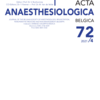Surgical adrenalectomy during rescue Extracorporeal Life Support for pheochromocytoma induced cardiogenic shock: a case report
Cardiogenic shock, ECMO, Pheochromo-cytoma, Adrenalectomy, Methylene blue
Published online: Mar 29 2022
Abstract
Introduction : Pheochromocytoma, a rare catecholamine-producing tumor, has been described to provoke stress-induced Takotsubo-like cardiomyopathy and even severe refractory cardiogenic shock. In this case report, venoarterial extracorporeal membrane oxygenation (VA-ECMO) was used for hemodynamic stabilization and was continued during the resection of a large neuroendocrine tumor.
Description : A 69-year old male, recently diagnosed with a pheochromocytoma, was referred to our center because of severe cardiogenic shock after induction of anesthesia for resection of the mass. Despite adequate alpha-and beta-adrenergic blockade for one month, he developed malignant hypertension with subsequently hemodynamic collapse. After successful cardiopulmonary resusci-tation he developed pulmonary oedema with severe hypoxemia and persistent hemodynamic lability. On arrival in our hospital, echocardiography revealed significant left ventricular impairment. Decision was made to commence him on VA-ECMO for a refractory cardiogenic shock with severe pulmonary oedema. Because of persistent blood pressure swings despite VA-ECMO and beta-adrenergic blockade, we decided to remove the tumor on mechanical circulatory support by an open surgical approach the next day. After clamping of the adrenal circulation, the patient experienced profound hypotension requiring high doses of epinephrine and a methylene blue infusion. Surgical resection was successful but complicated by a postoperative bleeding for which the patient underwent an emergent endovascular embolization of an adrenal artery. Over the next days, there was progressive cardiac recovery and the patient was weaned off VA-ECMO on the fourth postoperative day. The patient was discharged from the intensive care 27 days after admission and left the hospital on day 30.
Discussion: VA-ECMO seems to be a feasible last resort therapy in refractory cardiogenic shock induced by pheochromocytoma crisis as suggested by a high survival rate in literature. Despite its support benefit during this type of shock, surgical removal of the tumor is rarely done with mechanical circulatory support and heparinization.
